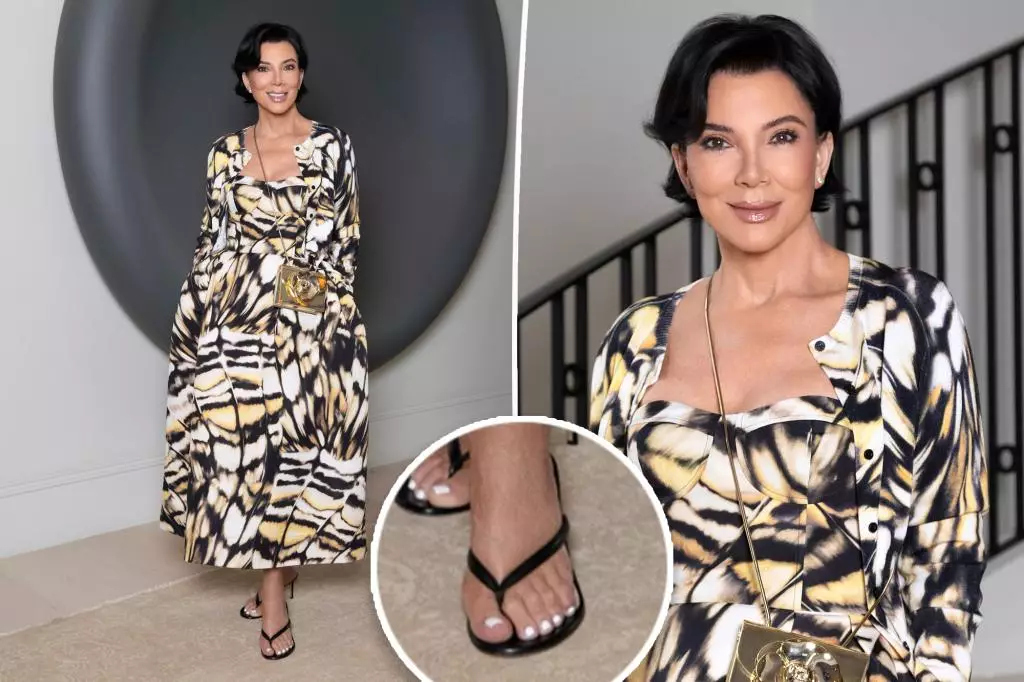The Kardashian-Jenner family has long been celebrated—and scrutinized—for their mastery of the visual narrative. In an era where social media dictates beauty standards and moment-to-moment perfection, maintaining an immaculate image has become not just an option but an unspoken obligation. However, this relentless pursuit of flawlessness often comes with a heavier cost: exposure. Every carefully curated post can unexpectedly reveal the cracks in the facade. The recent controversy surrounding Kris Jenner’s alleged sixth toe exemplifies this phenomenon. While it might seem trivial on the surface, it speaks to a deeper conversation about authenticity in the age of Photoshop and digital manipulation.
The incident at hand, where fans speculated about an extra toe in Jenner’s photos during her mother’s birthday celebration, underscores how even the most polished public figures are not exempt from scrutiny. The overwhelming response—laughter, disbelief, and curiosity—illustrates that audiences are increasingly attuned to inconsistencies. Far from being merely a humorous oversight, such visual anomalies threaten the perceived narrative of perfection that these media icons craft and, by extension, challenge societal standards themselves. It raises critical questions: Are these images genuine reflections of real life, or are they meticulously edited illusions designed to feed an insatiable appetite for idealized beauty?
The Long History of Digital Deception in the Kardashian-Jenner Ecosystem
This latest episode is merely the latest chapter in a long history of digital embellishments involving the family. For years, fans and critics alike have called out various posts for suspect Photoshop edits. Remember the 2019 KKW Fragrance campaign? Despite official explanations, the suspicion earned the campaign notoriety when some followers spotted irregularities in the models’ feet. The explanation—that the odd six-toe appearance was due to camera angles—seems fragile at best, especially when high-resolution images are scrutinized with a magnifying glass.
Kim Kardashian’s infamous Disneyland face swap further exemplifies how even a slight manipulation can backfire. Instead of genuine spontaneity, certain images have become symbolic of a desire to control perception—sometimes crossing the line into overt fabrication. Kim’s candid admission that she edited niece True Thompson’s face onto another grandniece’s body underscores a broader trend: even transparency can be a cover for perfectionism. Such incidents demonstrate that these carefully constructed images often resemble elaborate illusions rather than authentic moments. It reveals a collective obsession with maintaining an idealized image that, if exposed, threatens authentic human connection.
The Cultural Impact and Personal Costs of Photoshopping
These photoshop snafus are more than simple errors; they reflect a societal obsession with unattainable beauty. When influential figures with millions of followers project perfection, it sets unrealistic standards that impact self-esteem, mental health, and body image worldwide. The public’s quick exposure of these discrepancies reveals a paradox: we crave perfection yet vehemently reject artificiality when exposed.
The darker implication is that these manipulations can distort expectations, fostering environments where natural aging or genuine flaws are concealed or considered unacceptable. For the Kardashians and Jenners, the frequent editing controversies may fuel the narrative of eternal youth, but it also constructs a vicious cycle of comparison and dissatisfaction among their followers. Such practices, intentionally or not, propagate an unrealistic definition of beauty that can marginalize those who don’t fit the impossible mold.
Ironically, the obsession with flawless images suggests an insecurity rooted in the very fabric of celebrity culture. The push to appear ageless and immaculate often seems to be a desperate attempt to stave off mortality and the natural aging process. In a way, these photoshop controversies reveal the instability beneath the polished veneer—reminding us that beneath the glamour, everyone is grappling with vulnerability and imperfection. Yet, instead of embracing authenticity, these families often double down on digital perfection, perpetuating a cycle that sacrifices genuineness for the illusion of control and eternal youth.
—
The ongoing saga of manipulated images within the Kardashian-Jenner universe is not merely about who has the most perfect feet or the most unnatural backside—it’s a reflection of our collective obsession with superficial perfection. While these moments can be viewed as humorous or trivial, they also serve as powerful indicators of a culture that values appearance above authenticity. Recognizing this, one could argue that breaking free from these unrealistic standards may be one of the most revolutionary acts we can undertake in an image-obsessed society.

Leave a Reply